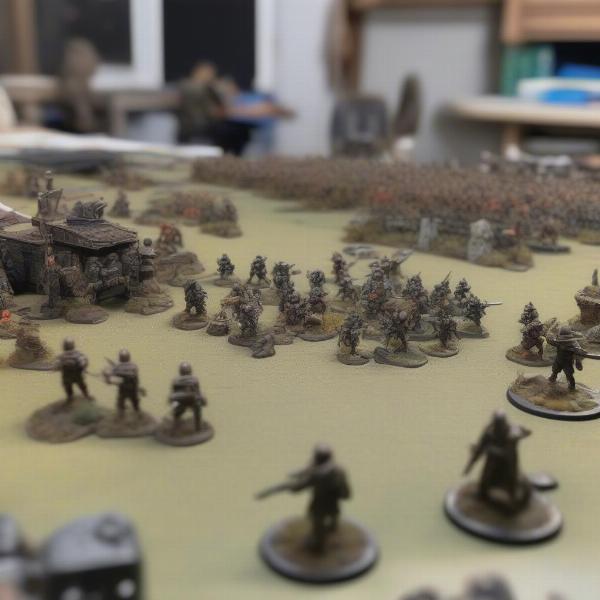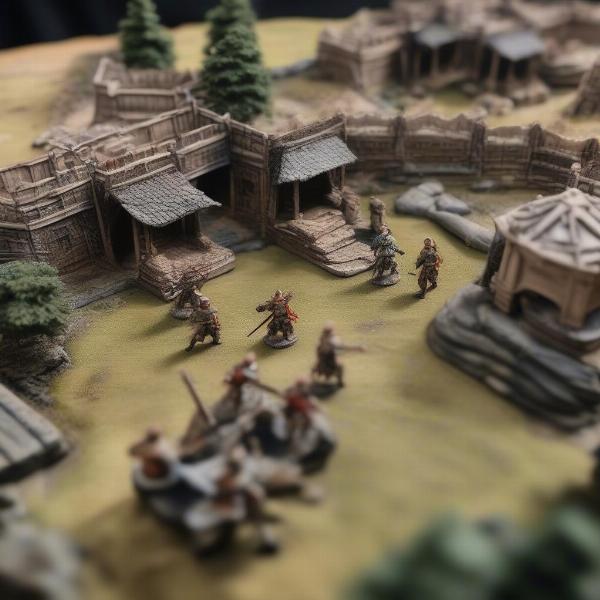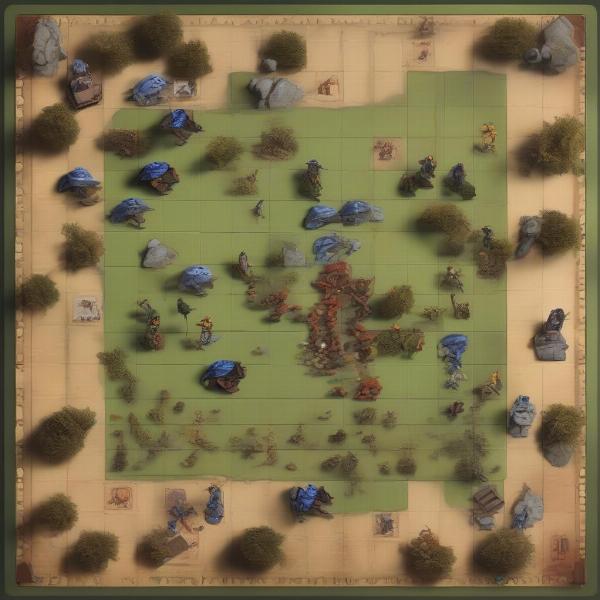Welcome to supremeduelist.blog, where we delve into the captivating world of tabletop gaming. Today, we’re focusing on the intricate and engaging hobby of Miniature Figures War Games. These games combine strategic depth, historical or fictional settings, and the joy of collecting and painting detailed figures, offering a unique experience unlike any other.
This article will guide you through the fundamental aspects of miniature war games, exploring their appeal, the different types available, and how to get started. We’ll also touch upon the strategies, the community, and what makes this hobby so compelling for enthusiasts around the globe. Let’s march into the world of tiny armies and epic battles!
What Are Miniature Figures War Games?
Miniature figures war games are tabletop games where players command forces of small, often highly detailed, figurines across a battlefield. These games go beyond simple board games, offering a more immersive and visually stimulating experience. Unlike traditional board games that use tokens or cards, miniature war games use sculpted figures that represent soldiers, tanks, monsters, and other battlefield units. The games often utilize rulebooks, dice, and measuring tools to determine movement, combat, and other game mechanics. These wargames are not just about luck; they require strategic thinking, careful planning, and tactical execution.
 Miniature figures arranged on a tabletop battlefield, showcasing strategic positions
Miniature figures arranged on a tabletop battlefield, showcasing strategic positions
Why Are Miniature War Games So Popular?
The popularity of miniature war games stems from several factors. Firstly, there’s the tactile appeal of handling and painting the miniatures themselves. Many enthusiasts find the process of assembling and customizing their armies to be just as rewarding as playing the game. Secondly, these games offer a high degree of strategic depth. Unlike some board games, where luck can play a large role, miniature war games demand careful planning and tactical decision-making. Players must understand their units, the terrain, and the objectives to achieve victory.
Another compelling aspect is the vibrant community that surrounds the hobby. Local gaming stores, online forums, and organized events create a social network for players to meet, share tips, and engage in friendly competition. The historical or fantasy settings often used in these games create immersive worlds that players can lose themselves in. Finally, there’s the aesthetic appeal of well-painted armies clashing on a meticulously crafted battlefield. “The visual component is just as important as the gameplay,” says expert miniature painter, Evelyn Reed. “The time invested in each miniature translates into the satisfaction of seeing your entire army come to life on the table.”
Types of Miniature War Games
The world of miniature war games is diverse, catering to a wide range of tastes and interests. Games can be broadly classified by theme, mechanics, and scale.
Historical War Games
Historical war games recreate battles from specific periods in history. From ancient Rome to World War II, these games aim for a level of historical accuracy in terms of unit types, tactics, and equipment. These games often appeal to history buffs and those who appreciate a more realistic gaming experience. For example, players interested in conflicts of the past might look at something like [american revolutionary war board games] which offers insights into historical strategy.
Fantasy and Sci-Fi War Games
These games transport players to fantastical worlds or futuristic settings. They often feature unique races, magical abilities, and advanced technologies. Fantasy and sci-fi war games emphasize creative gameplay and offer a break from historical realism. Many players enjoy the ability to command mythical creatures, powerful wizards, or space marines in these settings. The world of [star wars roleplaying game miniatures] exemplifies this category perfectly.
Skirmish vs. Mass Battle Games
Skirmish games involve smaller units and focus on the actions of individual soldiers or heroes. They often feature more complex rules for character development and close-quarters combat. Mass battle games, on the other hand, involve larger armies and emphasize tactical maneuvering and large-scale engagements. The choice between skirmish and mass battle depends on player preferences regarding complexity and the scope of the battles.
 A close-up of miniature figures engaged in a skirmish on a detailed terrain board
A close-up of miniature figures engaged in a skirmish on a detailed terrain board
Getting Started with Miniature War Games
Starting with miniature war games may seem daunting, but with a little guidance, it can be a rewarding experience. Here’s a breakdown of what you’ll need to get started:
Choosing a Game System
The first step is to choose a game system that interests you. Consider factors such as the setting, complexity of the rules, and the cost of miniatures. Research different systems online, read reviews, and perhaps visit a local game store to get a feel for the game. Do you prefer the classic look of [army men world war game], or something more fantastical?
Collecting Miniatures
Once you’ve chosen a system, it’s time to start collecting miniatures. You can either buy pre-assembled and pre-painted miniatures, or purchase plastic or metal kits that you assemble and paint yourself. Pre-assembled models are convenient for beginners; however, painting your own offers more customization and a fulfilling hobby experience. Many players find the process of collecting and painting their armies to be just as rewarding as playing the game.
Essential Supplies
Besides miniatures, you’ll need a few essential supplies: dice, measuring tools, rulebooks, and terrain. Dice are used to resolve combat and other actions, while measuring tools ensure accurate movement and distance calculations. Rulebooks provide all the necessary rules for playing the game, and terrain pieces help create visually appealing and tactically challenging battlefields. “A well-constructed battlefield is paramount to an enjoyable wargaming experience,” states terrain-building enthusiast, Thomas Davies. “It adds a level of immersion that’s hard to replicate otherwise.”
Learning the Rules
Every game system has its own unique rules. Spend some time reading the rulebook and watching tutorials online. Many communities offer introductory games to help new players learn the basics. Don’t be afraid to ask questions and seek clarification on anything that you find confusing.
Strategy and Tactics in Miniature War Games
Miniature war games are as much about strategy and planning as they are about rolling dice. Here are some key strategic and tactical considerations:
Understanding Your Army
Each unit in your army has its own strengths and weaknesses. Understanding these is crucial for effective gameplay. Some units may excel at close-quarters combat, while others are more effective at long-range engagements. Utilizing each unit effectively can make all the difference.
Terrain Awareness
Terrain plays a crucial role in miniature war games. Hills, forests, and buildings can provide cover, block line of sight, and influence movement. Using terrain to your advantage is a critical element of effective tactical gameplay. For example, using cover to protect your advancing forces, or occupying a hilltop to gain a firing advantage.
 Miniature figures using terrain for tactical advantage in a war game
Miniature figures using terrain for tactical advantage in a war game
Maneuvering and Positioning
Proper unit positioning and maneuvering is essential for outsmarting your opponent. Flanking, pincer attacks, and using feints can create advantageous situations in battle. Thinking ahead and anticipating your opponent’s moves can help you seize the initiative.
Objectives and Victory Conditions
Most miniature war games have specific objectives that players must achieve to win. These might include capturing strategic points, eliminating enemy units, or escorting valuable assets. Understanding the objectives of your scenario can help you focus your tactical and strategic planning.
Adaptability
The ability to adapt to changing circumstances is essential for success. Your opponent might execute unexpected maneuvers, or the dice might not roll in your favor. Being able to adjust your plans and react to the evolving situation on the battlefield is a vital skill for any miniature war gamer.
The Community and Social Aspect
Miniature war games are not just a solo activity; they thrive on community interaction. Local gaming stores, online forums, and organized events play a significant role in the hobby.
Local Game Stores
Local game stores often host regular miniature war game nights. These are great opportunities to meet fellow players, learn new techniques, and participate in friendly tournaments. Many stores also offer painting classes, terrain building workshops, and other related activities.
Online Communities
Online forums and social media groups provide platforms for players to connect, share tips, and discuss strategies. Many online communities also host virtual games for those who can’t meet in person.
Organized Events and Tournaments
Larger events and tournaments offer a more competitive experience. These can range from small local tournaments to massive international events. Organized play provides a chance to test your skills against a broader range of players and potentially win some prizes.
Collaborative Aspect
Besides competitive play, the hobby has a strong collaborative aspect. Many players enjoy painting and modeling their miniatures, and showing off their creations with other enthusiasts is part of the experience. It’s not uncommon for people to work together to create large, immersive dioramas or gaming boards. The collaborative aspect of painting and sharing within the community is as important as the games themselves.
Conclusion
Miniature figures war games offer a rich blend of strategy, creativity, and community engagement. They provide a unique tabletop gaming experience that appeals to a wide audience. From the tactical intricacies of gameplay to the artistic expression of painting and terrain building, this hobby has something for everyone. Whether you’re a history buff, a sci-fi enthusiast, or a fan of fantasy, there’s a miniature war game waiting for you.
The team at Supreme Duelist Blog encourages you to explore the fascinating world of miniature war games. Dive into this engaging hobby, and you’ll discover not just a fun pastime, but a vibrant community where you can develop your tactical skills, make new friends, and showcase your creativity. If you’re looking for more on games, consider checking out articles like [star wars the clone wars board game]. So, gather your forces, prepare your strategy, and join the epic battles today!
Leave a Reply